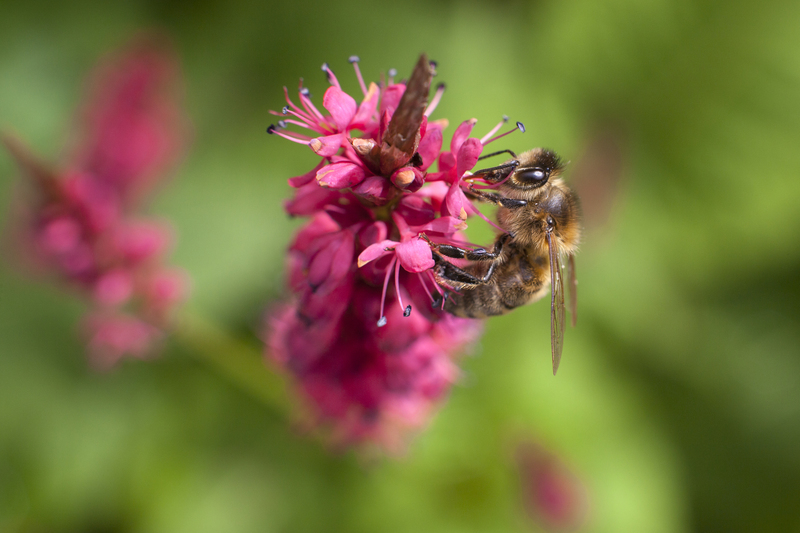Turning Waste into Nourishing Earth
Posted on 26/08/2025
Turning Waste into Nourishing Earth: A Comprehensive Guide
In our fast-paced, consumer-driven world, the problem of waste has reached critical levels. Yet, a surprising solution lies right beneath our feet: transforming our waste into rich, nourishing earth. By converting organic refuse into valuable soil, we not only reduce landfill waste but also foster healthy, sustainable ecosystems. In this article, we delve into the science and art of turning waste into nourishing earth, explore various methods, highlight environmental benefits, and offer practical tips for beginners and seasoned composters alike.

Understanding the Concept: What Does Turning Waste into Nourishing Earth Mean?
Turning waste into nourishing earth refers to the process of recycling organic material--such as kitchen scraps, yard trimmings, and even certain types of paper--into fertile compost or humus. This process, also known as organic waste transformation, brings myriad environmental, economic, and social benefits.
- Reduces landfill use: Diverts organic materials from overflowing landfills, cutting down harmful methane emissions.
- Enriches soil: Increases soil fertility, enhancing its structure and water-holding capacity.
- Promotes sustainability: Reduces reliance on chemical fertilizers and encourages a circular economy.
- Cuts greenhouse gases: Organics managed properly in composting produce far less methane than those left to rot in landfills.
Why Transforming Organic Waste Matters More Than Ever
With global waste generation predicted to increase by 70% by 2050, effective management strategies like composting are more critical than ever. Most household and commercial waste streams contain upwards of 30% organic matter, from food peels to coffee grounds and garden leaves. Rather than rotting uselessly, these can enrich our gardens and farmlands instead.
The Environmental Toll of Landfills
Landfills are not just eyesores--they are significant sources of methane, a greenhouse gas roughly 25 times more potent than carbon dioxide over a 100-year period. When organic matter decays without enough oxygen (anaerobically), methane is released in vast quantities. If that same material is composted properly, methane generation is virtually eliminated.
An Abundant Resource for Healthy Soil
Healthy soil teems with life. Compost, often referred to as "black gold," provides vital nutrients and beneficial microbes, improves soil structure, and helps retain moisture--all critical for resilient gardens and farms. By turning waste into nutrient-rich earth, we restore vital soil health that's been depleted by modern agriculture and urban development.
How Does Composting Work? The Science Behind Earth Nourishment
Composting is nature's way of recycling. Microorganisms--bacteria, fungi, and even larger critters like earthworms--break down organic materials into humus through aerobic (oxygen-friendly) decomposition. For optimal results, composting requires a balance of "greens" (nitrogen-rich material) and "browns" (carbon-rich material), moisture, and air.
- Greens: Fruit/veggie scraps, coffee grounds, grass clippings
- Browns: Dry leaves, shredded paper, wood chips, straw
- Moisture: Compost should be as moist as a wrung-out sponge for microbes to thrive
- Air: Turning or aerating the pile allows oxygen in and speeds decomposition
A well-managed compost pile will heat up as microbes do their work, breaking down waste material in a matter of months. Finished compost will look dark, crumbly, and smell earthy--a telltale sign of nourishing soil creation.
Innovative Approaches to Nutrient Recycling
Beyond backyard compost piles, high-efficiency methods offer urban dwellers and commercial operations the chance to turn waste into nourishing earth at scale:
Vermicomposting (Worm Composting)
Red wiggler worms devour kitchen scraps, producing castings--an exceptionally potent natural fertilizer. Worm bins fit easily in small spaces and can process up to a pound of food scraps weekly, making them ideal for apartments or classrooms.
Bokashi Fermentation
An anaerobic process using special microbes, Bokashi turns food waste (including meats and dairy that can't be composted traditionally) into a pre-compost ferment. The process is quick, odor-free, and suitable for compact spaces.
Commercial and Municipal Composting
In larger cities, curbside organics collection is driving massive organic waste transformation. Municipal composting facilities use controlled heat and aeration to manage tons of organic material, producing nutrient-dense soil amendments sold to farmers and landscapers.
Introducing Waste-to-Earth Strategies in Your Life
Ready to be part of the solution? Anyone can start turning waste into nourishing earth--whether you live in a house with a yard or a high-rise apartment. Here's how to get started:
Backyard Composting: The Basics
- Select a spot: Choose a dry, shady location near a water source for your pile or bin.
- Add your materials: Alternate layers of greens and browns for best results.
- Moisten as needed: Keep the pile damp, not soggy.
- Aerate regularly: Turn the pile every few weeks to boost oxygen and speed up decomposition.
Small-Space Solutions
- Countertop compost bins: Store food scraps temporarily before adding them to a larger bin or city compost service.
- Worm bins: Set up a vermicomposting unit under your sink or on a balcony.
- Bokashi buckets: Ferment nearly all food scraps indoors with minimal mess or smell.
Community Composting Initiatives
- Farmer's markets: Some offer drop-off points for household food scraps.
- Local gardens: Dozens of community gardens accept organic waste to fuel their soil health efforts.
- Municipal programs: Many cities now offer curbside pickups for food and yard waste--check your local government's website.
What Should--and Shouldn't--Go Into Compost?
For effective waste-to-earth transformation, knowing what to include is vital. Here's a quick guide:
Good to Compost
- Fruit & vegetable scraps
- Coffee grounds & tea leaves
- Eggshells
- Grass clippings & leaves
- Non-coated cardboard and paper towels
- Plant trimmings
Avoid Composting
- Meats, dairy, and oily foods (except in Bokashi systems)
- Invasive weeds or diseased plants
- Pet waste (can harbor pathogens)
- Glossy or coated papers
- Plastics and synthetic fibers
Sticking to the right ingredients keeps your compost healthy, safe, and odor-free.
The Environmental Benefits of Turning Waste Into Nourishing Earth
The positive impacts of organic waste transformation extend far beyond cleaner homes and gardens. Here are some key benefits:
- Soil health restoration: Compost feeds beneficial microbes and helps store carbon, mitigating climate change.
- Less waste to landfill: When families and communities compost, landfill needs shrink, saving space and municipal money.
- Reduced reliance on chemicals: Compost naturally fertilizes and strengthens plants, cutting the need for synthetic fertilizers and pesticides.
- Improved food security: Farmers and home gardeners alike benefit from increased yields thanks to healthy soil.
- Cleaner water: Healthy soils absorb more rain, reducing runoff and protecting waterways from nutrient pollution.
Common Challenges & Tricks for Successful Composting
Composting isn't always smooth sailing. Here's how to troubleshoot the most frequent obstacles when turning waste into nourishing earth:
Bad Odors
- Cause: Too much "green" material, lack of air, or excess moisture.
- Solution: Add more "browns," turn the pile, and make sure it's not too wet.
Pests
- Cause: Attracted by food scraps, especially meat or dairy.
- Solution: Use closed bins or bury food scraps deeper within the pile.
Slow Decomposition
- Cause: Pile too dry, too cold, or not enough air.
- Solution: Moisten the compost, turn more frequently, and try chopping materials smaller for faster breakdown.
How to Use Your Home-Made Nourishing Earth
Once your compost is ready, you'll find countless uses for this nutrient-rich earth:
- Garden beds: Mix thoroughly into vegetable or flower beds for healthier, more productive plants.
- Potting mixes: Blend with soil for indoor plants and container gardens.
- Lawn dressing: Spread thinly on your lawn to naturally fertilize and build strong turf.
- Tree and shrub planting: Add to planting holes to encourage root growth.
Remember, a little compost goes a long way--a 1/2 inch layer on top of garden soil is generally enough to boost fertility and moisture retention for an entire season.
The Future of Turning Waste into Nourishing Earth
New technologies and growing environmental awareness are expanding the horizons of waste-to-soil initiatives. Smart bins track composition and usage, biotech startups engineer efficient decomposers, and cities design integrated organics recycling systems. The vision? Zero-waste communities and sustainable agriculture fueled by a steady stream of healthy, home-made compost.
Each banana peel composted, each pile turned, is a step toward a regenerative, circular economy where nothing is wasted--everything is transformed for the good of our planet.

FAQs on Turning Waste into Nourishing Earth
1. How long does it take to compost household waste?
Depending on the method and conditions, compost can mature in as little as 2-3 months (well-managed hot pile) or as long as a year (cool, low-input piles).
2. Is composting possible in apartments?
Absolutely! Methods like vermicomposting and Bokashi bins are designed for small, odor-free, indoor processing.
3. Can I compost in winter?
Yes--though decomposition slows in cold temperatures. You can continue adding organics and the process will resume as it warms.
4. Does composting attract pests?
Properly managed (covered and aerated) compost should not attract pests. Avoid meats and keep a good balance of browns to minimize risk.
5. What are alternatives if local compost pickup isn't available?
Seek out community composters at gardens or farmers' markets, start a neighborhood drop-off, or use indoor composting solutions.
Conclusion: Your Role in Nourishing the Earth
The journey of turning waste into nourishing earth is both ancient and urgent. Every one of us plays a part in this natural cycle--by composting, supporting local compost programs, or spreading the word. The humble act of recycling food scraps or leaves doesn't just reduce waste; it regenerates our earth, strengthens our food systems, and helps create a sustainable future for all. Embrace the cycle--join the movement to turn waste into nourishing earth today!

